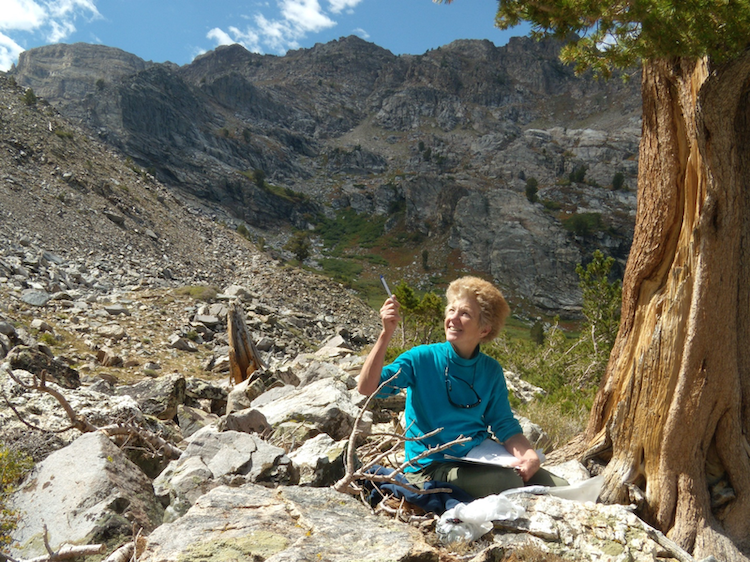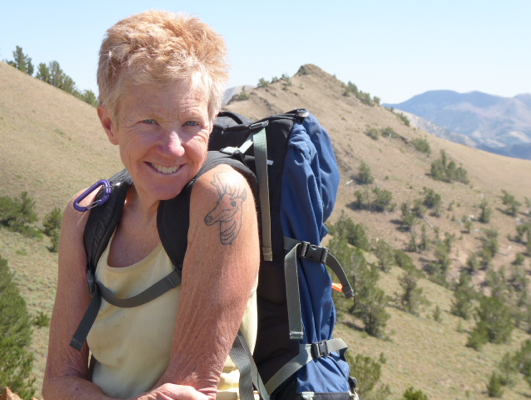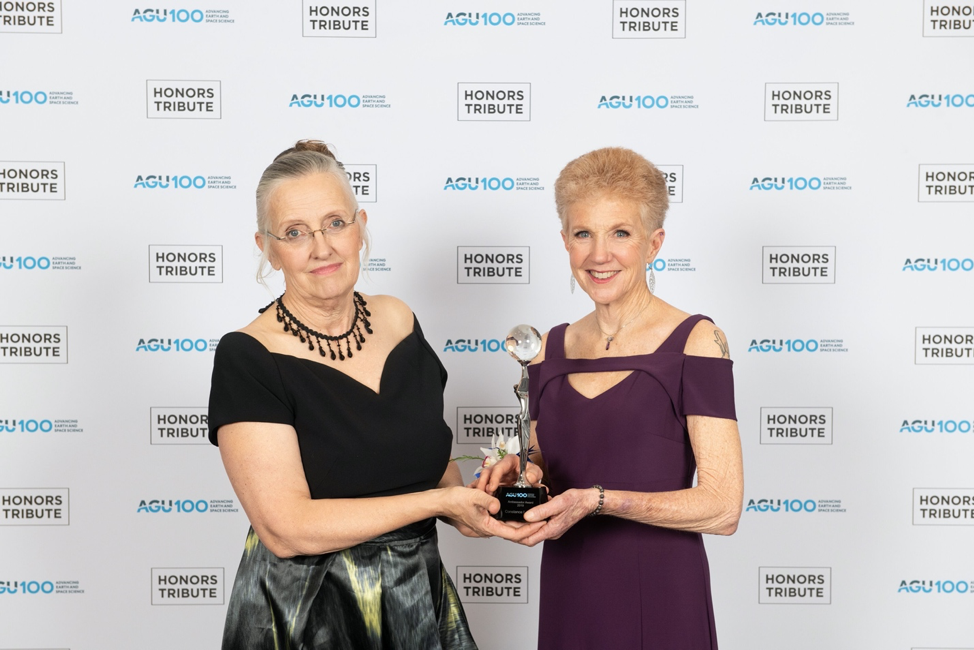
During the 2019 Annual Meeting of the American Geophysical Union (AGU) in San Francisco, California, Dr. Constance Millar, USDA Forest Service Pacific, Southwest Research Station, Albany, California, was honoured with an AGU Ambassador Award. The award was given for her outstanding contributions and inspiring interdisciplinary research and leadership on how mountain flora and fauna adapt to climate change, and for building a diverse scientific community to guide management of these natural resources.
MRI Scientific Project Officer Aino Kulonen talked with Connie about her career and the importance of interdisciplinary research in tackling global change challenges in mountain environments.
AK: You’ve had a long and outstanding career as an ecologist. How did you first get into studying mountains?
CM: Thank you. From the day I could walk, so my parents would tell me, I wanted to be in the mountains. That passion has never died, and my true home will always be amidst lofty pine forests and rocky heights. Hiking the uplands as a teen in the Cascade Range of Oregon (my family home) cemented that ease and familiarity, while also opening my eyes to mysteries that I encountered (“What is Douglas-fir doing on the east side of the Cascades?” was the title of a high-school science project). I was forever curious about trees, how they grew, and why they were where they are. My family had a log cabin in an old-growth ponderosa pine (Pinus ponderosa) forest on the east slope of the Cascades, at the edge of the high desert. I imprinted on that landscape. When I moved to California for graduate school in 1977, I sought out the familiar pine forests, rugged mountains, and alpine landscapes of the Great Basin, reminiscent of my childhood in the eastern Cascades. I haven’t strayed from this region since. My early years wandering and wondering outdoors conditioned me to become first and foremost a field scientist.
AK: What drives your passion for mountain sciences?

CM: I am most excited when I can leverage the natural ability of mammals (including humans) to recognize pattern in nature and use it as a springboard for learning. A longtime colleague once asked, “You seem to make your research around stories of unique conditions and events.” And she was right: my strategy, an easy one given my love and curiosity for mountain environments, has been to immerse myself in a place and learn about it from every angle and season, under extreme and ordinary conditions. In so doing, if one keeps eyes and ears open, pattern imprints almost unconsciously in our minds, such that anything encountered outside the pattern leaps out. Those novel situations then become a valuable focus of research, where one can ask, “Why doesn’t this follow expectations from scientific theory?” and, “How does this ‘errant condition’ inform me about possible limitations in existing scientific theory”? For example, my observations of treeline ecotones in mountains of the Great Basin suggested that pines weren’t (only, or at all) moving upslope in response to contemporary warming, as theory suggests. That led to studies to investigate why they weren’t moving up, and what else was going on. This approach is similar to mutation analysis in genetics, which was my academic training: Mutations can be very useful for dissecting natural processes that are otherwise difficult to approach.
AK: What led you to multidisciplinary research?
CM: I think I always have been interested in the bigger picture. This is partly due to my nature, and stems from loving everything about mountains, which made me want to look across disciplines. Also, I confess that I am not a detail person or a perfectionist, which is why my career-long research associates, Bob Westfall and Diane Delany, have been essential partners— they are detail-oriented! In my early career with the USFS I asked my beloved University of Washington undergraduate advisor, Dr. Reini Stettler, whether he thought I was going astray by not focusing on one discipline. Reini pointed out that there are many ways a scientist can have a unique and valuable career—some specialize in single themes, others develop expertise by having unique combinations of many specialties. Later I asked a similar question of my then-USFS-boss, Dr. Tom Ledig, and he assured me that it was important to pursue research I was interested in, to address important and useful questions, and to conduct my science with transparency and honesty. How lucky we are to have these elder voices along the journey!
AK: You’ve once said that “Interdisciplinary mountain research is for people who like steep learning curves”. Could you elaborate on that?
CM: Yes, that is probably another reason I like to work across disciplines: I love the part of learning where everything is new. Further, if one has a focal environment, such as my Great Basin mountains, then learning a new field is bound to answer some long-held questions, which is immensely gratifying, as well as lead to a host of new questions. For example, limber pine (Pinus flexilis) is uncommon in the central Sierra Nevada where I work, but common farther south in the range. Decades ago, it became clear to me that it occurred in the central range only on isolated patches of odd rocky slopes. Delving into periglacial geomorphology, I came to realize that these were till of relict Pleistocene rock glaciers, common but widely overlooked in the Sierra Nevada, which helped to explain why the pines were there. That led to a new chapter in my career, studying rock glaciers and their unique, cold micro-climates, which were also off the radar at the time. These led further to documenting permafrost in these warm Mediterranean climate mountains, countering long-held assumptions of its non-existence in the range. Work on periglacial features brought me to study the small mountain mammal, American pika (Ochotona princeps), whose habitat is confined to rock glaciers, talus, and related rocky landforms. Pikas had become an icon for climate vulnerability, but once we understood that their habitats are uniquely “air-conditioned,” it became clearer why they are widespread in warm, arid regions (e.g., the Great Basin), countering widely held expectations.
I encourage everyone to be comfortable with not knowing things, and to freely ask questions of those who do. I think scientists of any age want to save face, and tend to stay in their comfort zone. What is to lose by boldly going into the unknown?
AK: In this community many know you from the activities of Consortium for Integrated Climate Research in Western Mountains (CIRMOUNT). What is the story behind the success of this interdisciplinary network
CM: In the late 20th century a movement emerged in environmental science across North America to conduct major regional ecosystem assessments. These required interdisciplinary work, throwing scientists from fields as diverse as environmental law, sociology, hydrology, atmospheric science, forest ecology, and wildlife biology into single teams. I was fortunate to be involved with one of these efforts, the Sierra Nevada Ecosystem Project (SNEP). I recall initially feeling adrift and almost a bit ill from the cultural clashes among scientists of different disciplines: I could barely understand the language of my social science or physics team members. It was revealing to see how easy it is for humans to be clannish. Eventually I got used to the “otherness.”
During those years the idea of integrative research was in the air. I met Greg Greenwood (former MRI executive director), and other western mountain scientists who would later comfortably and naturally look to each other and say, “We should be working together across disciplines in western North American mountains to integrate research and better understand the effects of climate change!” That was the seed of the effort to rally together and tackle climate-related problems concertedly at cross-disciplinary and bioregional scales. With key players Henry Diaz (NOAA); Mike Dettinger (USGS); Kelly Redmond (DRI-WRCC); Malcolm Hughes, Lisa Graumlich, and Tom Swetnam (University of Arizona); Dave Peterson (USFS); Greg Greenwood (MRI); Dan Cayan (UCSD); Dan Fagre and Nate Stephenson (USGS), and myself, we advanced by baby steps to test the water. In 2002 and then 2003 we organized sessions on “Integrated Climate Research in Mountains” at various existing annual conferences. Finding interest at these, In 2004 we hosted the first full conference on the topic, as the “Mountain Climate Science Symposium” at Lake Tahoe, CA. From there the regular MtnClim Climate Conferences, now held biennially, were launched. I attribute any success of them to the fact that they offer serious science, across disciplines, in beautiful and informal settings (the mountains!).
Seeking further ways to communicate, in 2007 Henry Diaz and I launched the CIRMOUNT newsletter, Mountain Views, later Mountain Views Chronicle, which I now edit. I like to think that the same theme of serious science integrated with informal essays and art makes that forum useful to keep the community together. I further hope to think everyone with science or resource interest in mountains feels welcome and valued in the loose-knit CIRMOUNT community.
CIRMOUNT has advantage and disadvantage in that it never became a formal, official institution. The grass-roots nature kept options easy and open (no Board of Directors to ask for things). On the other hand, we lack the benefits that a Board of Directors with staff and operating budget would offer.
AK: You are known for speaking for and opening channels for Early Career Researchers, female scientists and minority voices in general.

CM: There is no question to me that the well-understood problem of lack of representation in a particular community hinders inclusivity. As I was coming of age there were few women in the field and especially lacking in leadership roles. I took as models my male colleagues and rarely felt I could muster the capacity to do science as they did, thus I questioned whether I could succeed. Only later when I worked with senior women scientists did I begin to realize that I function quite differently—some but not all of this is related to my sex. In my experience I never felt consciously excluded or discriminated by my male colleagues, more that I didn’t resonate with the way they worked or the way they talked during meetings and informal interactions. These felt foreign to me, and I often felt like an outsider. In sum, I think that unconscious bias of many stripes remains a thriving barrier to achieving diversity in our science ranks for all kinds of scientists, not just women or minorities. Busting through unconscious bias is hard, but can be done if one is determined.
Learn more about Connie’s research and career on her homepage and about the AGU Ambassador Award on the US Forest Service homepage.
Cover photo by Jeff Wyneken

